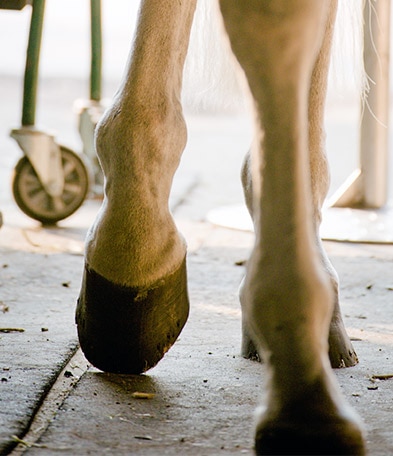No Hoof, No Horse!
Learn how to keep your horse’s feet healthy
By: Dr. Lydia Gray

Step one in preventive hoof care is understanding the subject so you can communicate knowledgeably with your farrier, veterinarian, trainer and others. If you aren’t sure where the heel, toe and quarter are, or can’t point to the hoof wall, sole and frog, brush up on your anatomy and terminology.
Step two in preventive hoof care is selecting and working with your horse’s healthcare team of farrier and veterinarian. You may already have a farrier that works well with you and your horse. But if you’re unhappy with your current services, need to find a farrier for any other reason, ask your veterinarian for a referral or visit one of these websites for names of farriers in your area:
These websites also offer tips for choosing an appropriate farrier for your situation, including important questions to ask on the first phone call. For example, if your horse loses a shoe, how soon can this farrier come out and replace it? Or if your horse needs corrective work, is this farrier skilled enough to provide it? Perhaps you need a farrier that can catch your horse and work by himself—is this farrier willing to provide this extra service? Most importantly, is this farrier willing to work side-by-side with your veterinarian to do what is best for your horse? Once you’ve found a farrier (and veterinarian) that fits your bill, make sure they stick around by being a great client: have your horse caught and cleaned up ahead of time, ask questions but follow recommendations, and above all, pay your bills on time!
Step three in preventive hoof care is what you can do to ensure your horse’s feet are as healthy as possible. You have two means of improving hoof quality at your disposal
- from the inside (providing optimum nutrition)
- from the outside (controlling his environment)
Optimum nutrition for a horse includes high-quality hay (and pasture, if available), nutrients like vitamins and minerals to meet his daily nutritional requirements, and calories to maintain his body condition. For active horses, both nutrients and calories may come in the form of fortified grain. For less active horses or “easy keepers,” a forage-balancer or multi-vitamin/mineral supplement may be more appropriate. For some horses, this formula may be enough. However, because of genetics, location, type of use and other factors, other horses may need additional supplementation to grow a healthy hoof. Independent university research has shown that a supplement containing biotin, lysine, methionine, Vitamin C, zinc, copper and other nutrients improved both the quantity and quality of hoof growth in horses with a variety of hoof defects.
To improve the quality of hooves from the outside, make sure the environment is “hoof friendly,” that is, consistent and gentle. Experts believe a constantly changing environment may be worse than one that has too much moisture or not enough so avoid going from wet to dry to wet conditions. Don’t give your horse a full bath if a sponge-off will do, don’t allow him to stand in mud, and don’t let his stall become wet with urine and manure. For some horses or some situations, additional help in the way of topical hoof products may be necessary. Ask your farrier and veterinarian for their advice, but in general avoid pertroleum or tar-based products or ones that contain anything you wouldn’t put on your own skin. Lanolin-based products or hoof sealants won’t damage the hoof and may help create a barrier to unavoidable changes in moisture.
Hooves are the foundation for everything we do with our horses. Learn to speak the language of the hoof, build a caring and competent farrier/veterinary team, and do your part to develop a strong, sound foot through nutrition and consistent care.
SmartPak strongly encourages you to consult your veterinarian regarding specific questions about your horse's health. This information is not intended to diagnose or treat any disease, and is purely educational.